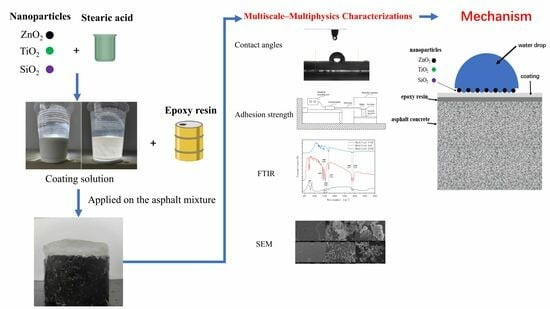Influence of Preparation Methods and Nanomaterials on Hydrophobicity and Anti-Icing Performance of Nanoparticle/Epoxy Coatings
Abstract
:1. Introduction
2. Materials and Methods
2.1. Raw Materials
2.2. Preparation of the Nanoparticle Hydrophobic Materials
2.3. Preparation of the Hydrophobic Coatings
2.3.1. Application Method
2.3.2. Preparation of Coated Marshall Specimens
- (1)
- Preparation of nanoparticle/epoxy hybrid coatings
- (2)
- Preparation of ZnO/epoxy layered coating
2.4. Characterization of Hydrophobic Materials and Coatings
2.5. Adhesion Test
- (1)
- Simulation of manual deicing
- (2)
- Measurement of surface ice adhesion
- (3)
- Formation of ice-covered layer and control of the quantitative area
2.6. Simulation Test of Icing
2.7. Durability Test of Coatings
3. Results and Discussion
3.1. Determination of the Optimum Preparation Method
3.1.1. Dispersion Method
3.1.2. Application Method
3.1.3. Introduction Method for Epoxy Resin
3.2. Contact Angles of Asphalt Concrete with Nanocomposite Coatings
3.2.1. Influence of Mass Ratio of Nanoparticles to Stearic Acid on Contact Angle
3.2.2. Influence of Dosage of Nanoparticle to Hydrophobic Materials on Contact Angle
3.3. Fourier-Transform Infrared (FT-IR) Spectroscopy Analysis
3.4. Scanning Electron Microscopy (SEM) Analysis
3.5. Ice Adhesion Strength of Asphalt Concrete with Nanocomposite Coatings
3.6. Icing Proportion of Asphalt Concrete with Nanoparticle Coatings
3.7. Contact Angle Attenuation of Coatings with Different Epoxy Resin Contents
4. Conclusions
- The optimum preparation method of nanoparticle/epoxy coating is ultrasonic dispersion and layered spraying. This is because the reaction degree of nanoparticles and stearic acid of unprocessed, magnetically stirred, and ultrasonically dispersed samples increased successively. In addition, layered spraying makes nanoparticles exposed to shape the rough surface.
- The mass ratio of nanoparticles to stearic acid and dosage of nanoparticle to hydrophobic materials have a significant impact on the contact angle of the hydrophobic coating. If the amount of stearic acid was more than the optimum value, the hydrophilic carboxyl group in the unreacted stearic acid and the hydrophobic interactions of stearic acid reduced the hydrophilicity of the coating. In addition, as the nanoparticle content increases, the aggregation of nano-particles becomes more serious, which makes the dispersion of nanoparticles more difficult and the hydrophobicity growth rate of the coating worse.
- The FTIR analysis shows that the hydroxyl group on the surface of nanoparticles was replaced by the carboxyl group of stearic acid and it existed on the surface of nanoparticles in the form of coordination adsorption. The reaction degree of TiO2 and SiO2 with stearic acid was lower than that of ZnO, which could explain the low hydrophobicity of the TiO2 and SiO2 coatings.
- The SEM analysis shows that the ZnO/epoxy layered coating has a layered structure. The lower layer of the epoxy resin solution can enhance the durability of the coating and the upper layer of the zinc oxide solution can form a rough hydrophobic surface.
- The hydrophobic coating can reduce the adhesion strength of ice and asphalt concrete, which decreases with the increase in nanoparticle dosage.
- The hydrophobic coating has a good inhibiting effect on icing. Moreover, the inhibiting effect on icing of the ZnO, TiO2, and SiO2 hydrophobic coatings decreases in turn. In the environments of −10 and −2 °C, the hydrophobic coating delayed the beginning icing time by up to 30 min and at least 2 h, respectively.
- In coating durability tests, the attenuation of contact angle decreased with the increased dosage of the mass ratio of epoxy resin to nanoparticle, indicating that the epoxy resin significantly improved the durability of the coating.
Author Contributions
Funding
Data Availability Statement
Conflicts of Interest
References
- Boinovich, L.B.; Emelyanenko, A.M. Anti-icing Potential of Superhydrophobic Coatings. Mendeleev Commun. 2013, 23, 3–10. [Google Scholar] [CrossRef]
- Laforte, J.L.; Allaire, M.A.; Laflamme, J. Wind tunnel evaluation of a rime metering device using a magnetostrictive sensor. Atmos. Res. 1995, 36, 287–301. [Google Scholar] [CrossRef]
- Chen, M.; Wu, S.; Wang, H.; Zhang, J. Study of ice and snow melting process on conductive asphalt solar collector. Sol. Energy Mater. Sol. Cells 2011, 95, 3241–3250. [Google Scholar] [CrossRef]
- Liu, X.; Rees, S.J.; Spitler, J.D. Modeling snow melting on heated pavement surfaces. Part I: Model development. Appl. Therm. Eng. 2007, 27, 1115–1124. [Google Scholar] [CrossRef]
- Tang, X.-W.; Jiao, S.-J.; Gao, Z.-Y.; Xu, X.-L. Study of 5.8 GHz magnetron in microwave deicing. J. Electromagn. Waves Appl. 2008, 22, 1351–1360. [Google Scholar] [CrossRef]
- Daniels, J.W.; Heymsfield, E.; Kuss, M. Hydronic heated pavement system performance using a solar water heating system with heat pipe evacuated tube solar collectors. Sol. Energy 2019, 179, 343–351. [Google Scholar] [CrossRef]
- Hou, Z.; Li, Z.; Tang, Z. Study on electrical properties of carbon fiber electrically conductive concrete for deicing or snowmelting. J. Wuhan Univ. Technol. 2002, 24, 32–34. [Google Scholar]
- Abraham, M.; Claudio, D.V.; Stefano, S.; Alidad, A.; Drelich, J.W. Contact angles and wettability: Towards common and accurate terminology. Surf. Innov. 2017, 5, 3–8. [Google Scholar] [CrossRef]
- Li, Q.; Guo, Z.G. Fundamentals of icing and common strategies for designing biomimetic anti-icing surfaces. J. Mater. Chem. A 2018, 6, 13549–13581. [Google Scholar] [CrossRef]
- Guo, P.; Zheng, Y.M.; Wen, M.X.; Song, C.; Lin, Y.C.; Jiang, L. Icephobic/Anti-Icing Properties of Micro/Nanostructured Surfaces. Adv. Mater. 2012, 24, 2642–2648. [Google Scholar] [CrossRef]
- Pstrowska, K.; Gunka, V.; Sidun, I.; Demchuk, Y.; Vytrykush, N.; Kułażyński, M.; Bratychak, M. Adhesion in Bitumen/Aggregate System: Adhesion Mechanism and Test Methods. Coatings 2022, 12, 1934. [Google Scholar] [CrossRef]
- Zhang, S.N.; Huang, J.Y.; Chen, Z.; Yang, S.; Lai, Y.K. Liquid mobility on superwettable surfaces for applications in energy and the environment. J. Mater. Chem. A 2019, 7, 38–63. [Google Scholar] [CrossRef]
- Wu, X.H.; Zhao, X.; Ho, J.W.C.; Chen, Z. Design and durability study of environmental-friendly room-temperature processable icephobic coatings. Chem. Eng. J. 2019, 355, 901–909. [Google Scholar] [CrossRef]
- Barthlott, W.; Neinhuis, C. Purity of the sacred lotus, or escape from contamination in biological surfaces. Planta 1997, 202, 1–8. [Google Scholar] [CrossRef]
- Laforte, C.; Laforte, J.; Carrière, J. How a solid coating can reduce the adhesion of ice on a structure. In Proceedings of the International Workshop on Atmospheric Icing of Structures (IWAIS), Brno, Czech Republic, 17–20 June 2002. [Google Scholar]
- Arabzadeh, A.; Ceylan, H.; Kim, S.; Gopalakrishnan, K.; Sassani, A. Superhydrophobic Coatings on Asphalt Concrete Surfaces: Toward Smart Solutions for Winter Pavement Maintenance. Transp. Res. Rec. J. Transp. Res. Board 2016, 2551, 10–17. [Google Scholar] [CrossRef]
- Ruan, M.; Li, W.; Wang, B.; Deng, B.; Ma, F.; Yu, Z. Preparation and anti-icing behavior of superhydrophobic surfaces on aluminum alloy substrates. Langmuir 2013, 29, 8482–8491. [Google Scholar] [CrossRef]
- Yang, J.; Li, W. Preparation of superhydrophobic surfaces on Al substrates and the anti-icing behavior. J. Alloys Compd. 2013, 576, 215–219. [Google Scholar] [CrossRef]
- Antonini, C.; Innocenti, M.; Horn, T.; Marengo, M.; Amirfazli, A. Understanding the effect of superhydrophobic coatings on energy reduction in anti-icing systems. Cold Reg. Sci. Technol. 2011, 67, 58–67. [Google Scholar] [CrossRef]
- Dotan, A.; Dodiuk, H.; Laforte, C.; Kenig, S. The relationship between water wetting and ice adhesion. J. Adhes. Sci. Technol. 2009, 23, 1907–1915. [Google Scholar] [CrossRef]
- Li, G.; Yue, J.; Guo, C.; Ji, Y. Influences of modified nanoparticles on hydrophobicity of concrete with organic film coating. Constr. Build. Mater. 2018, 169, 1–7. [Google Scholar] [CrossRef]
- Peng, C.; Hu, Y.; You, Z.; Yang, H.; Nie, Y.; Wu, T.; Yang, H.; Ou, R. Preparation and anti-icing performance of acrylic superhydrophobic asphalt pavement coating with microwave heating function. Constr. Build. Mater. 2022, 344, 128289. [Google Scholar] [CrossRef]
- Zhang, D.; Wang, L.; Qian, H.; Li, X. Superhydrophobic surfaces for corrosion protection: A review of recent progresses and future directions. J. Coat. Technol. Res. 2016, 13, 11–29. [Google Scholar] [CrossRef]
- Li, X.; Cao, Z.; Zhang, Z.; Dang, H. Surface-modification in situ of nano-SiO2 and its structure and tribological properties. Appl. Surf. Sci. 2006, 252, 7856–7861. [Google Scholar] [CrossRef]
- Schmidt, D.F.; Giannelis, E.P. Silicate Dispersion and Mechanical Reinforcement in Polysiloxane/Layered Silicate Nanocomposites. Chem. Mater. 2010, 22, 167–174. [Google Scholar] [CrossRef]
- He, F.Q.; Zhao, Y.P. Growth of ZnO nanotetrapods with hexagonal crown. Appl. Phys. Lett. 2006, 88, 193113. [Google Scholar] [CrossRef]
- Wang, B.-B.; Feng, J.-T.; Zhao, Y.-P.; Yu, T.X. Fabrication of Novel Superhydrophobic Surfaces and Water Droplet Bouncing Behavior—Part 1: Stable ZnO–PDMS Superhydrophobic Surface with Low Hysteresis Constructed Using ZnO Nanoparticles. J. Adhes. Sci. Technol. 2010, 24, 2693–2705. [Google Scholar] [CrossRef]
- Wang, B.B.; Zhao, Y.P.; Yu, T.X. Fabrication of Novel Superhydrophobic Surfaces and Droplet Bouncing Behavior—Part 2: Water Droplet Impact Experiment on Superhydrophobic Surfaces Constructed Using ZnO Nanoparticles. J. Adhes. Sci. Technol. 2011, 25, 93–108. [Google Scholar] [CrossRef]
- Ding, B.; Ogawa, T.; Kim, J.; Fujimoto, K.; Shiratori, S. Fabrication of a super-hydrophobic nanofibrous zinc oxide film surface by electrospinning. Thin Solid Film. 2008, 516, 2495–2501. [Google Scholar] [CrossRef]
- Chen, H.; Wu, Y.; Xia, H.; Jing, B.; Zhang, Q. Review of ice-pavement adhesion study and development of hydrophobic surface in pavement deicing. J. Traffic Transp. Eng. 2018, 5, 224–238. [Google Scholar] [CrossRef]
- Li, Y.; Sha, A.; Tian, Z.; Cao, Y.; Li, X.; Liu, Z. Review on superhydrophobic anti-icing coating for pavement. J. Mater. Sci. 2023, 58, 3377–3400. [Google Scholar] [CrossRef]
- Wu, X.H.; Chen, Z. A mechanically robust transparent coating for anti-icing and self-cleaning applications. J. Mater. Chem. A 2018, 6, 16043–16052. [Google Scholar] [CrossRef]
- Zhuo, Y.; Håkonsen, V.; He, Z.; Xiao, S.; He, J.; Zhang, Z. Enhancing the Mechanical Durability of Icephobic Surfaces by Introducing Autonomous Self-Healing Function. ACS Appl. Mater. Interfaces 2018, 10, 11972–11978. [Google Scholar] [CrossRef] [PubMed]
- Makkonen, L. Ice Adhesion—Theory, Measurements and Countermeasures. J. Adhes. Sci. Technol. 2012, 26, 413–445. [Google Scholar] [CrossRef]
- Rønneberg, S.; He, J.; Zhang, Z. The need for standards in low ice adhesion surface research: A critical review. J. Adhes. Sci. Technol. 2020, 34, 319–347. [Google Scholar] [CrossRef]
- Bleszynski, M.; Clark, E. Current Ice Adhesion Testing Methods and the Need for a Standard: A Concise Review. Standards 2021, 1, 117–133. [Google Scholar] [CrossRef]
- JTG E20-2011; Standard Test Methods of Bitumen and Bituminous Mixtures for Highway Engineering. Ministry of Transport of the People’s Republic of China: Beijing, China, 2011.
- Zhang, X.; Shi, F.; Niu, J.; Jiang, Y.; Wang, Z. Superhydrophobic surfaces: From structural control to functional application. J. Mater. Chem. 2008, 18, 621–633. [Google Scholar] [CrossRef]
- Huhtamäki, T.; Tian, X.; Korhonen, J.T.; Ras, R.H.A. Surface-wetting characterization using contact-angle measurements. Nat. Protoc. 2018, 13, 1521–1538. [Google Scholar] [CrossRef]
- Ruiz-Cabello, F.J.M.; Rodríguez-Valverde, M.A.; Cabrerizo-Vílchez, M.A. Equilibrium contact angle or the most-stable contact angle? Adv. Colloid Interface Sci. 2014, 206, 320–327. [Google Scholar] [CrossRef]
- Quéré, D. Wetting and Roughness. Annu. Rev. Mater. Res. 2008, 38, 71–99. [Google Scholar] [CrossRef]
- Peng, C.; Zhang, H.; You, Z.; Xu, F.; Jiang, G.; Lv, S.; Zhang, R.; Yang, H. Preparation and anti-icing properties of a superhydrophobic silicone coating on asphalt mixture. Constr. Build. Mater. 2018, 189, 227–235. [Google Scholar] [CrossRef]
- Golovin, K.; Dhyani, A.; Thouless, M.D.; Tuteja, A. Low–interfacial toughness materials for effective large-scale deicing. Science 2019, 364, 371–375. [Google Scholar] [CrossRef] [PubMed]
- Gao, W.; Zhou, B.; Liu, Y.H.; Ma, X.Y.; Liu, Y.; Wang, Z.C.; Zhu, Y.C. The influence of surface modification on the structure and properties of a zinc oxide-filled poly(ethylene terephthalate). Polym. Int. 2013, 62, 432–438. [Google Scholar] [CrossRef]
- Zhu, W.K.; Wu, Y.; Zhang, Y. Fabrication and characterization of superhydrophobicity ZnO nanoparticles with two morphologies by using stearic acid. Mater. Res. Express 2019, 6, 1150d1. [Google Scholar] [CrossRef]
- Ma, F.; Chen, S.; Liu, P.; Geng, F.; Li, W.; Liu, X.; He, D.; Pan, D. Improvement of β-TCP/PLLA biodegradable material by surface modification with stearic acid. Mater. Sci. Eng. C 2016, 62, 407–413. [Google Scholar] [CrossRef] [PubMed]
- Arfaoui, M.A.; Dolez, P.I.; Dube, M.; David, E. Development and characterization of a hydrophobic treatment for jute fibres based on zinc oxide nanoparticles and a fatty acid. Appl. Surf. Sci. 2017, 397, 19–29. [Google Scholar] [CrossRef]
- Zheng, C.; Cheng, Y.M.; Wei, Q.B.; Li, X.H.; Zhang, Z.J. Suspension of surface-modified nano-SiO2 in partially hydrolyzed aqueous solution of polyacrylamide for enhanced oil recovery. Colloids Surf. A Physicochem. Eng. Asp. 2017, 524, 169–177. [Google Scholar] [CrossRef]
- Wenzel, R.N. Resistance of Solid Surfaces to Wetting by Water. Ind. Eng. Chem. 1936, 28, 988–994. [Google Scholar] [CrossRef]
- Marmur, A. Super-hydrophobicity fundamentals: Implications to biofouling prevention. Biofouling 2006, 22, 107–115. [Google Scholar] [CrossRef]
- Cassie, A.B.D.; Baxter, S. Wettability of porous surfaces. Trans. Faraday Soc. 1944, 40, 546–551. [Google Scholar] [CrossRef]
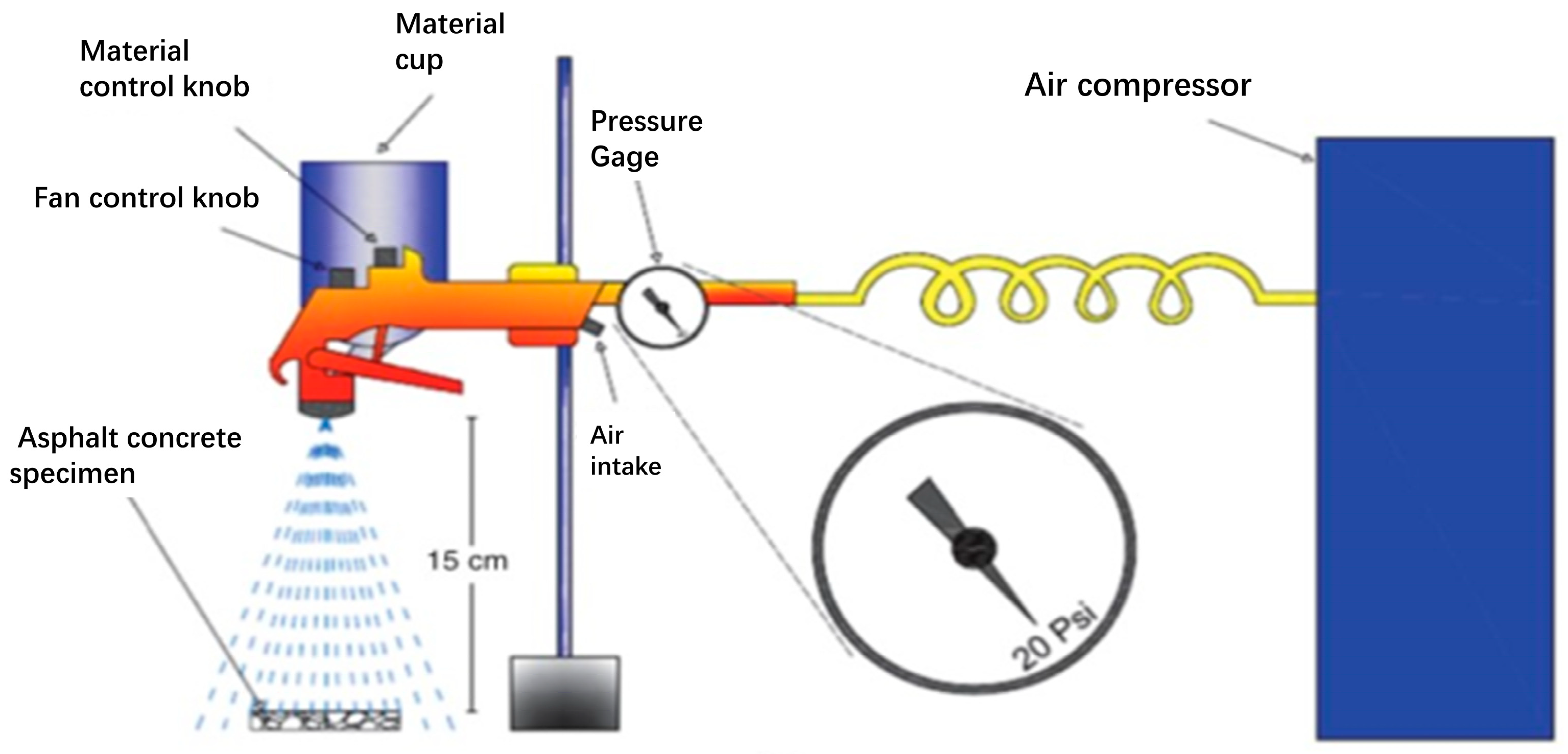


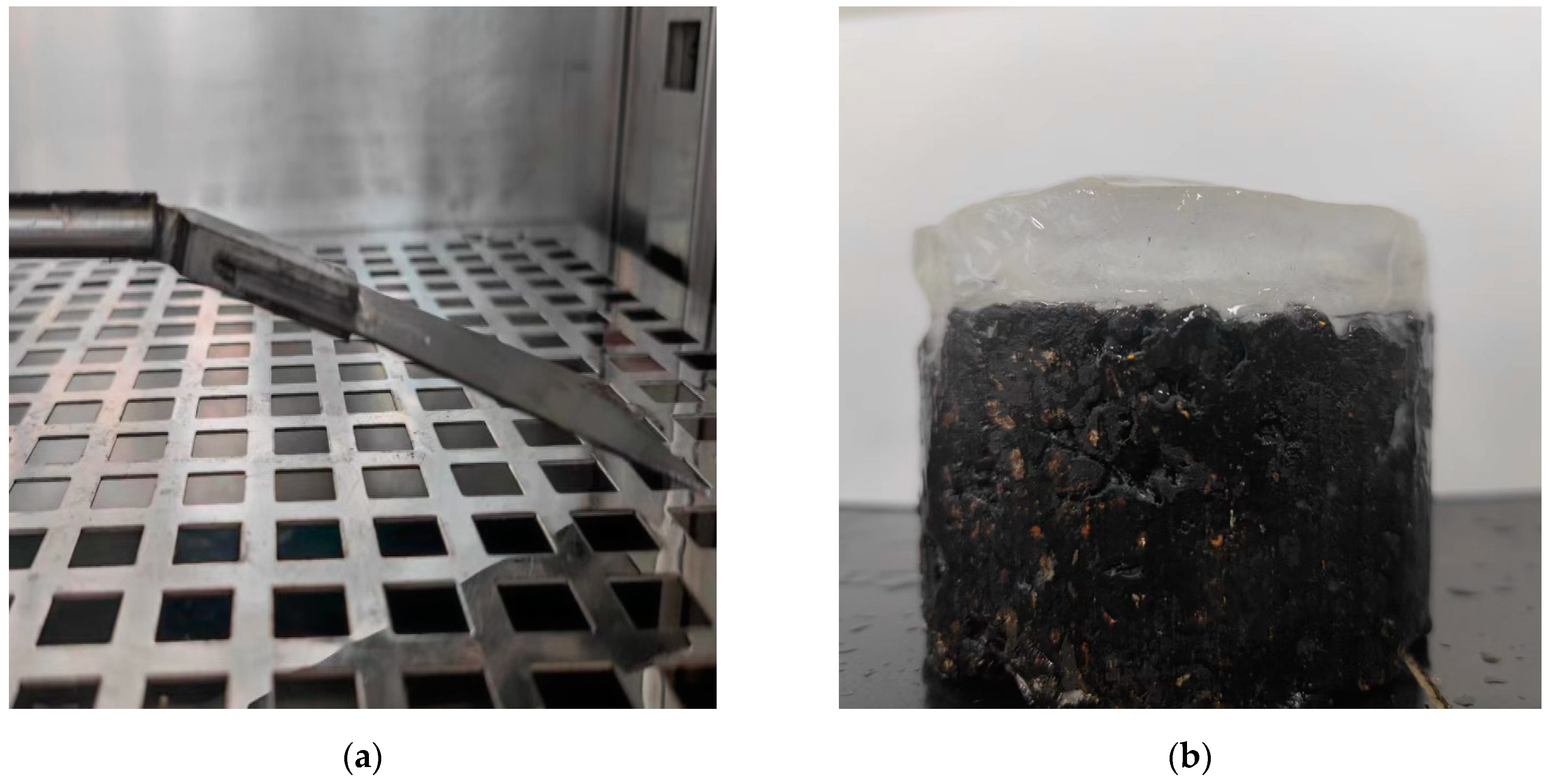

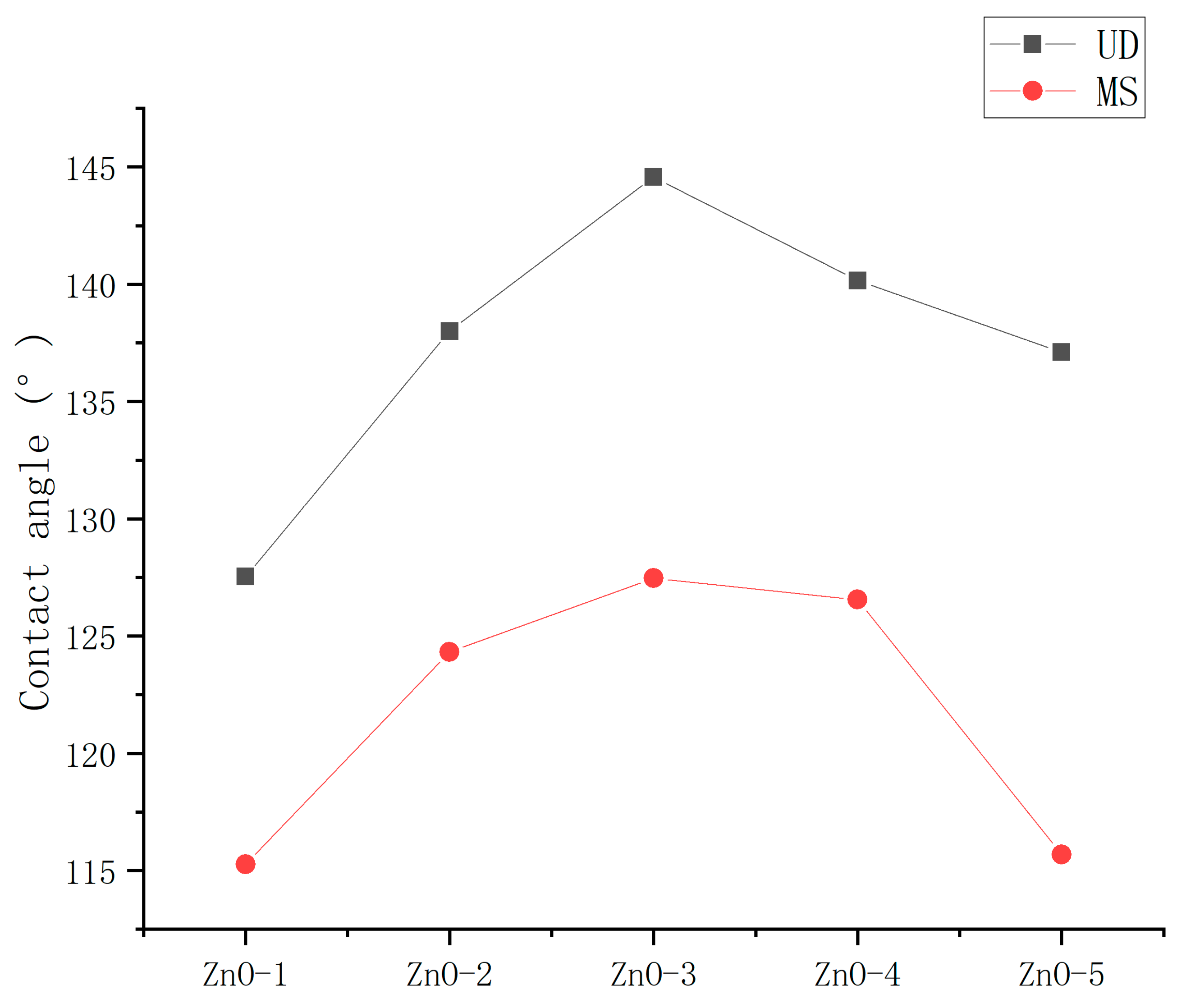

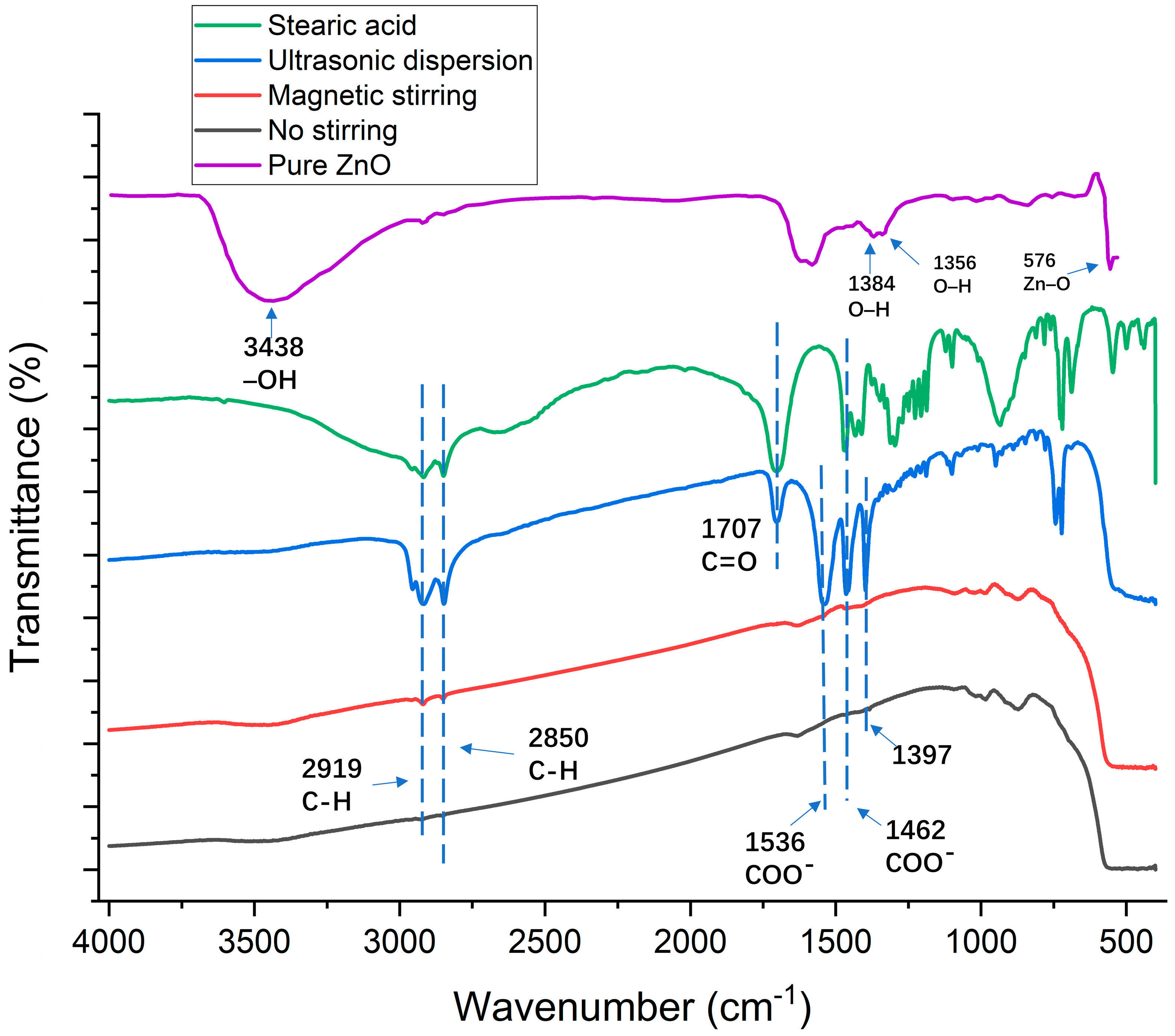
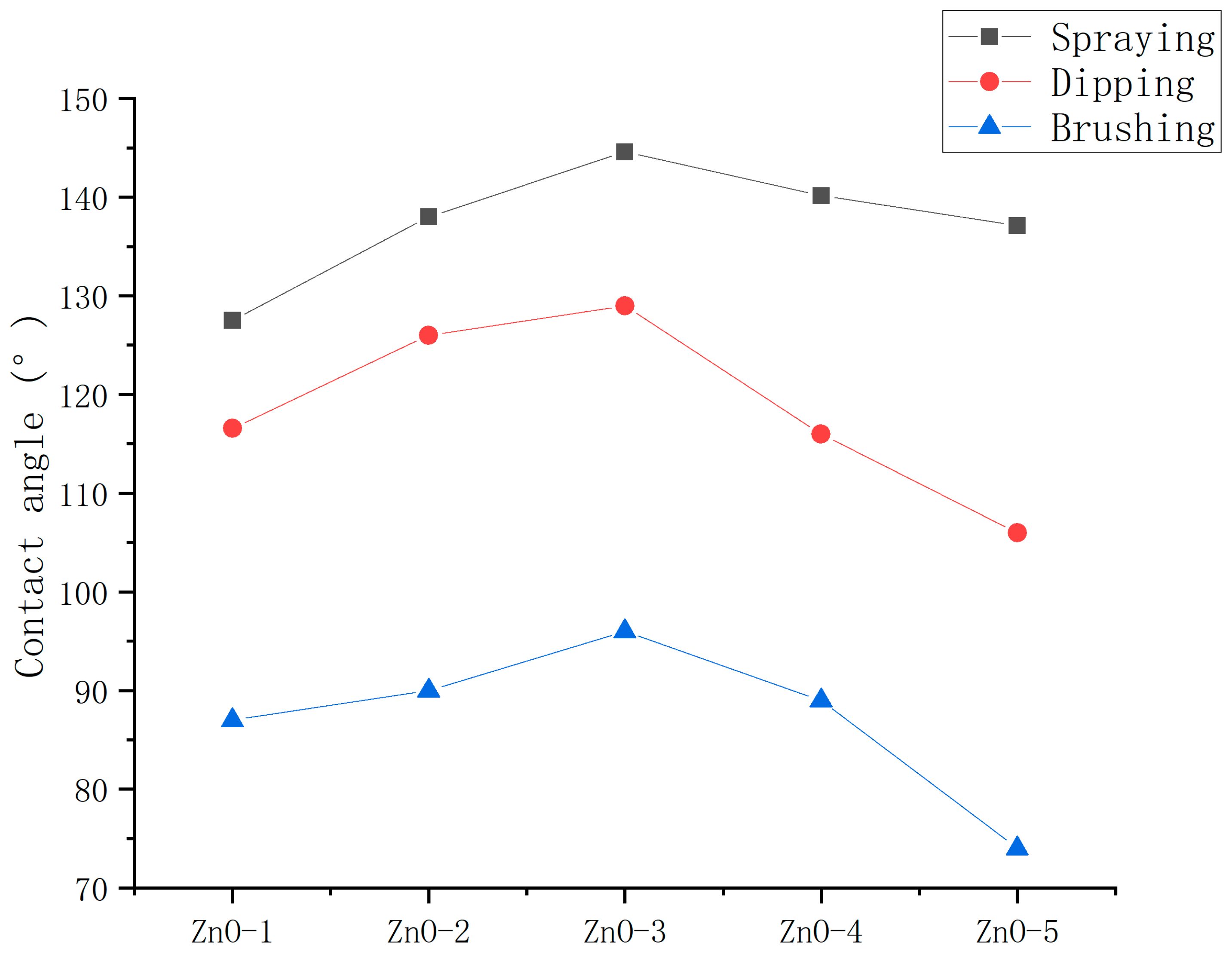



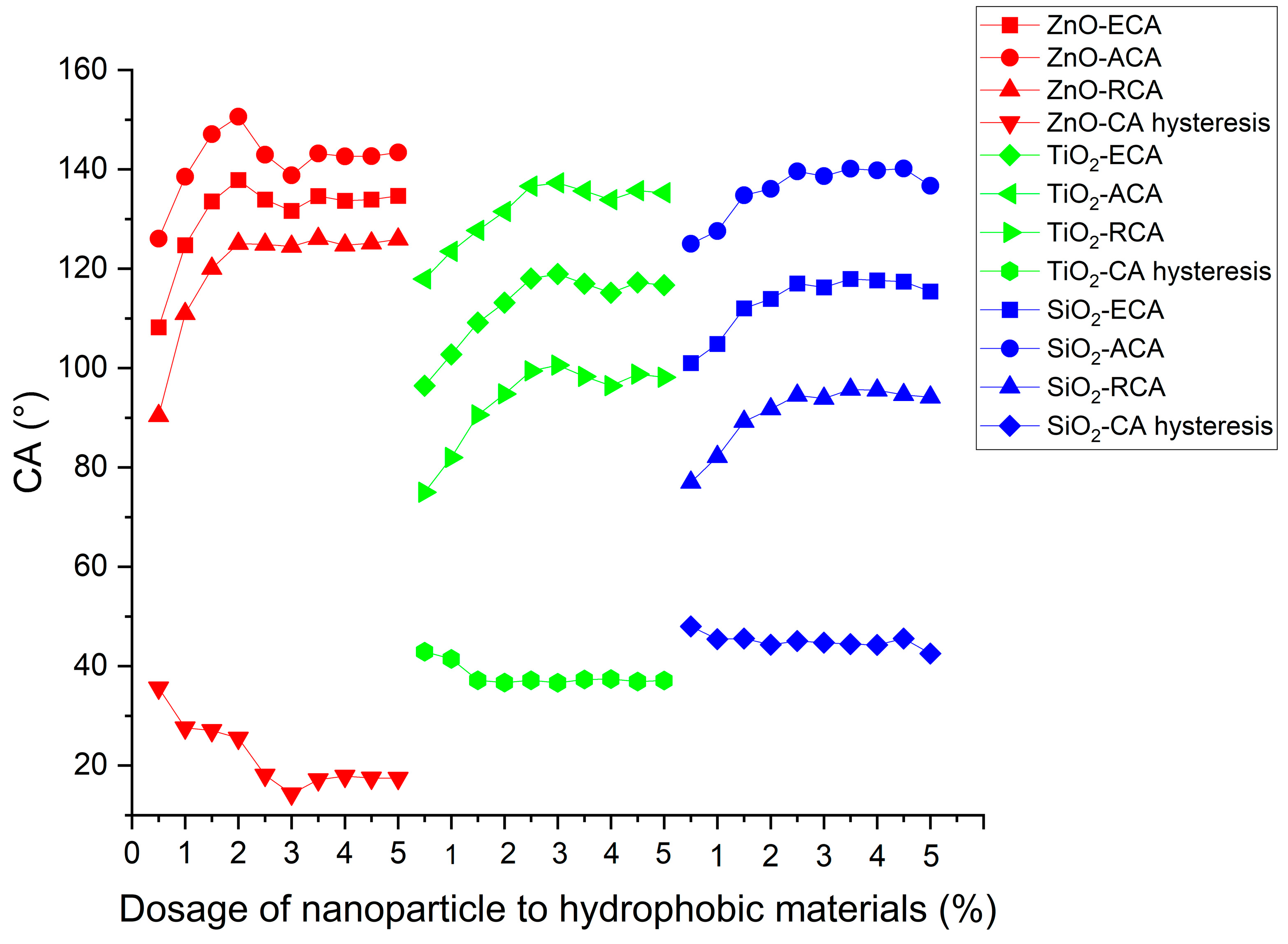
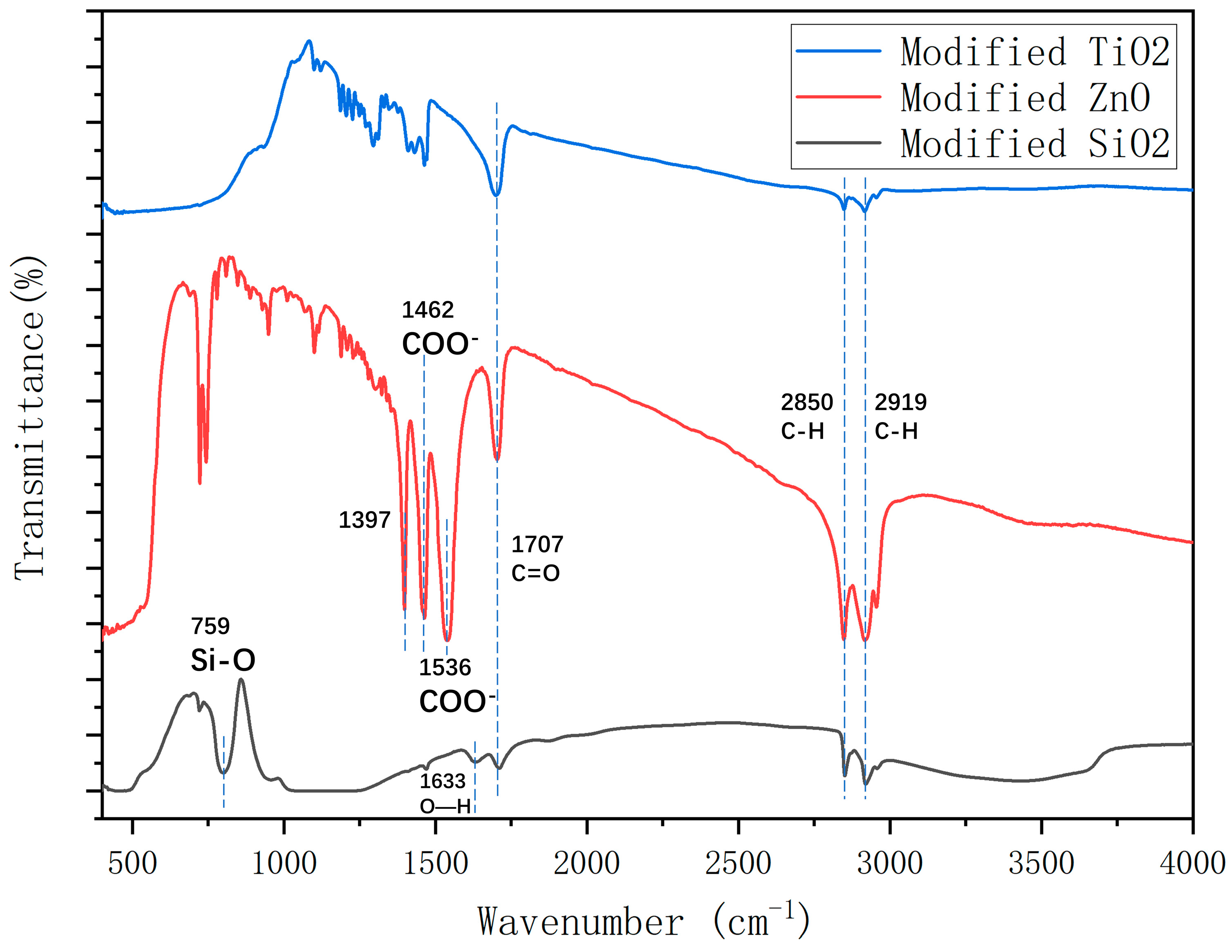
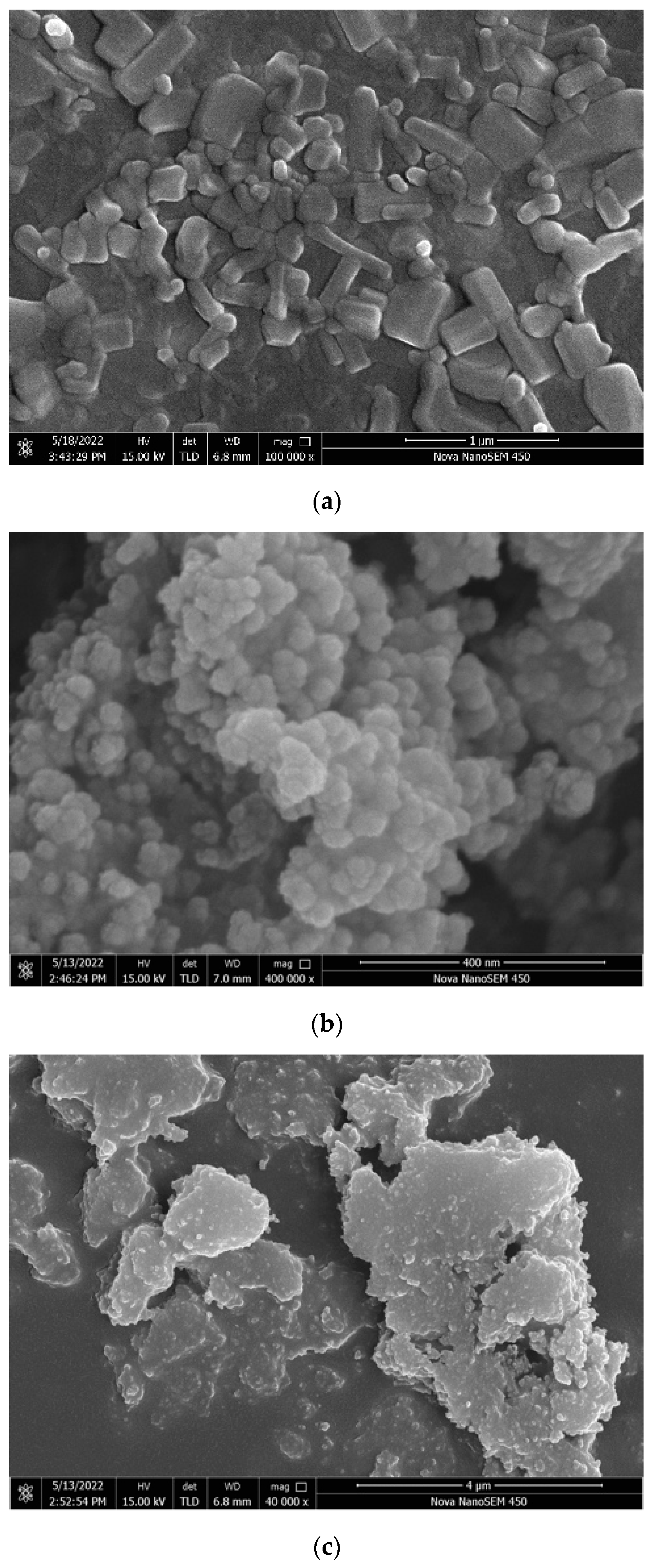
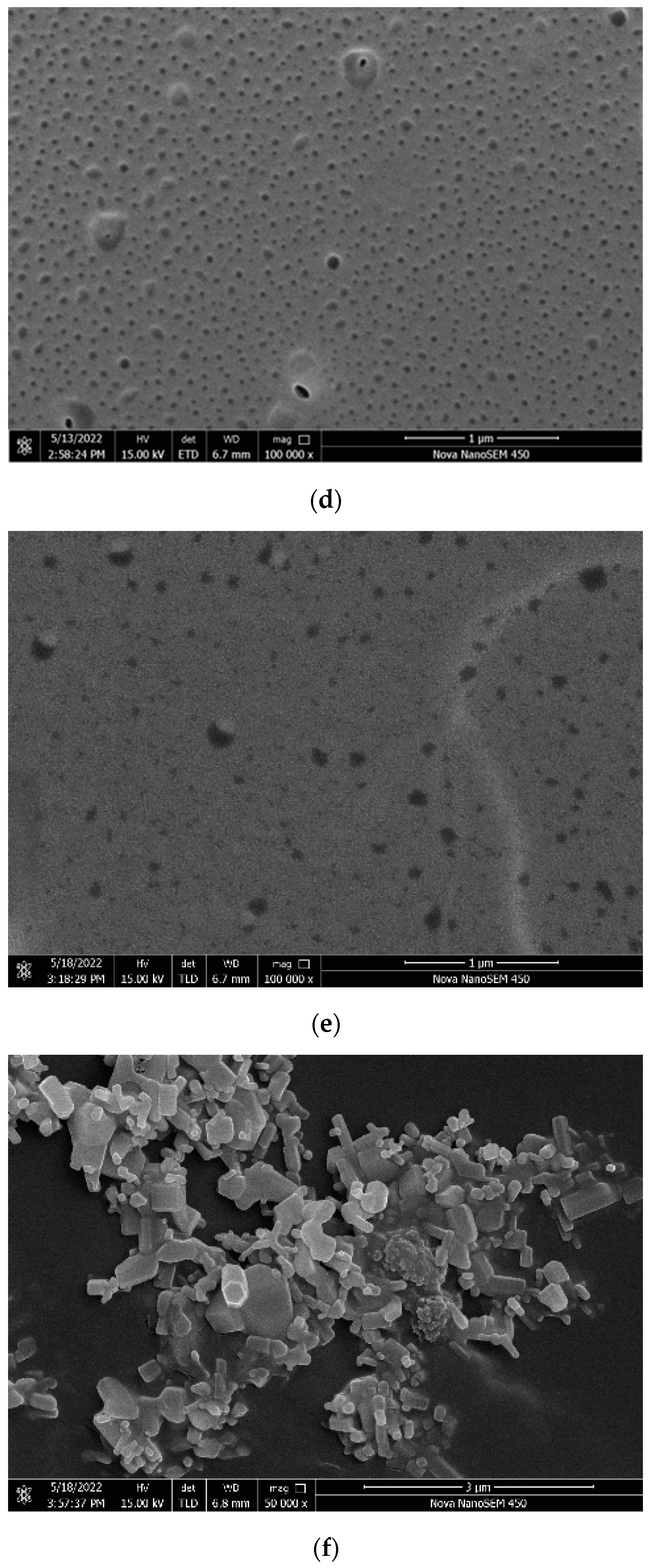

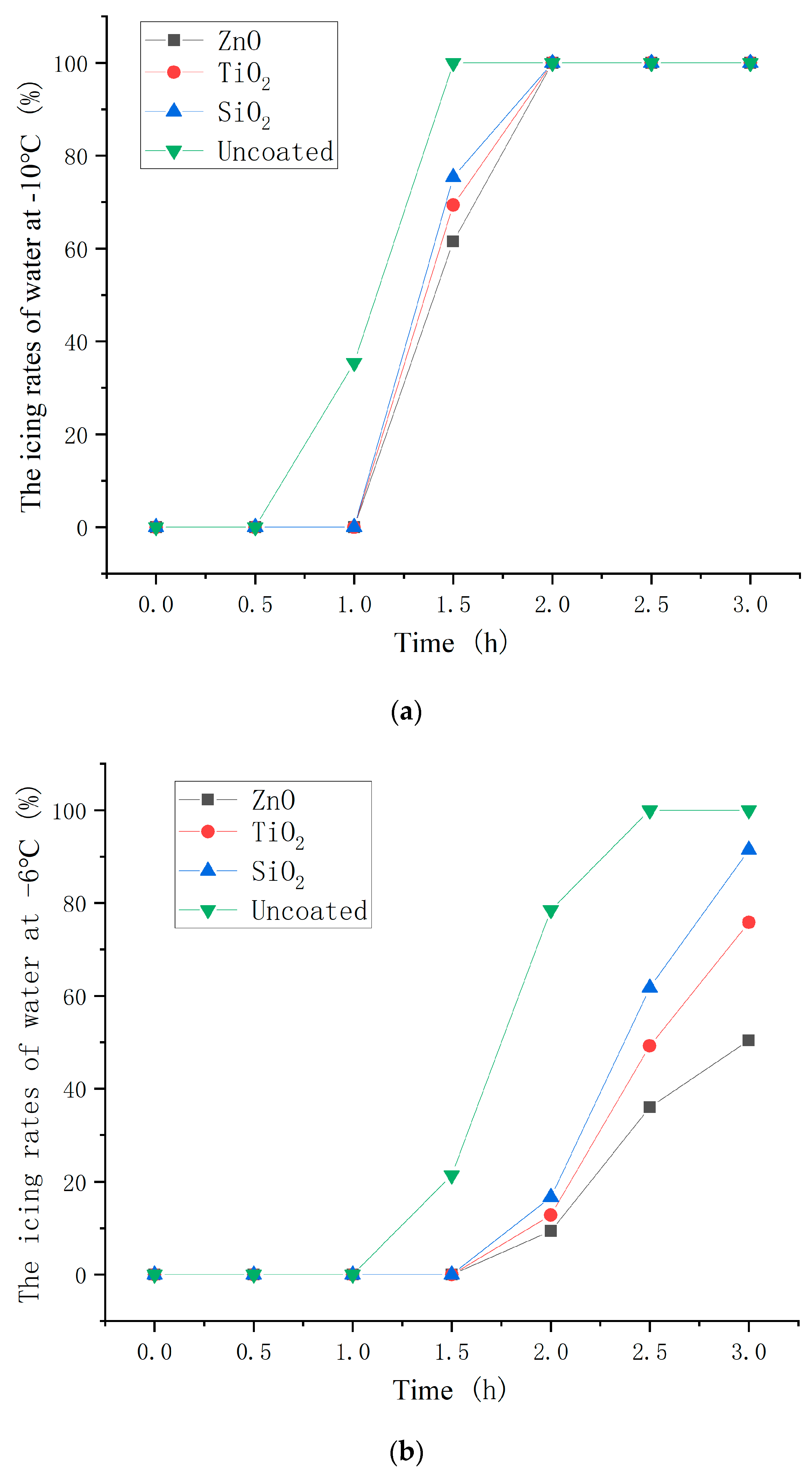


| Properties | Pen70 Asphalt |
|---|---|
| Penetration (25 °C)/0.1 mm | 66.8 |
| Softening point/°C | 49.4 |
| Ductility (15 °C)/cm | 145.7 |
| Sample | Nanoparticle (g) | Stearic Acid (g) | Mass Ratio of Nanoparticle to Stearic Acid | Molar Ratio of Nanoparticle to Stearic Acid | Anhydrous Ethanol (mL) | Epoxy Resin (g) | |
|---|---|---|---|---|---|---|---|
| ZnO-1 | ZnO (g) | 5 | 1.05 | 4.76:1 | 1:0.06 | 100 | 5 |
| ZnO-2 | 5 | 1.40 | 3.57:1 | 1:0.08 | 100 | 5 | |
| ZnO-3 | 5 | 1.75 | 2.86:1 | 1:0.1 | 100 | 5 | |
| ZnO-4 | 5 | 2.10 | 2.38:1 | 1:0.12 | 100 | 5 | |
| ZnO-5 | 5 | 2.45 | 2.04:1 | 1:0.14 | 100 | 5 | |
| SiO2-1 | SiO2 (g) | 5 | 2.84 | 1.76:1 | 1:0.12 | 100 | 5 |
| SiO2-2 | 5 | 3.32 | 1.51:1 | 1:0.14 | 100 | 5 | |
| SiO2-3 | 5 | 3.79 | 1.32:1 | 1:0.16 | 100 | 5 | |
| SiO2-4 | 5 | 4.27 | 1.17:1 | 1:0.18 | 100 | 5 | |
| SiO2-5 | 5 | 4.74 | 1.05:1 | 1:0.2 | 100 | 5 | |
| TiO2-1 | TiO2 (g) | 5 | 0.89 | 5.62:1 | 1:0.05 | 100 | 5 |
| TiO2-2 | 5 | 1.78 | 2.81:1 | 1:0.1 | 100 | 5 | |
| TiO2-3 | 5 | 2.67 | 1.87:1 | 1:0.15 | 100 | 5 | |
| TiO2-4 | 5 | 3.56 | 1.40:1 | 1:0.2 | 100 | 5 | |
| TiO2-5 | 5 | 4.45 | 1.12:1 | 1:0.25 | 100 | 5 |
| Dosage of Nanoparticle to Hydrophobic Materials (%) | Nanoparticle (g) | Stearic Acid (g) | Anhydrous Ethanol (g) | Epoxy Resin (g) | |
|---|---|---|---|---|---|
| 0.50 | ZnO(g) | 5 | 1.75 | 993.25 | 5 |
| 1.00 | 5 | 1.75 | 493.25 | 5 | |
| 1.50 | 5 | 1.75 | 326.58 | 5 | |
| 2.00 | 5 | 1.75 | 243.25 | 5 | |
| 2.50 | 5 | 1.75 | 193.25 | 5 | |
| 3.00 | 5 | 1.75 | 159.92 | 5 | |
| 3.50 | 5 | 1.75 | 136.11 | 5 | |
| 4.00 | 5 | 1.75 | 118.25 | 5 | |
| 4.50 | 5 | 1.75 | 104.36 | 5 | |
| 5.00 | 5 | 1.75 | 93.25 | 5 | |
| 0.50 | SiO2(g) | 5 | 3.79 | 991.21 | 5 |
| 1.00 | 5 | 3.79 | 491.21 | 5 | |
| 1.50 | 5 | 3.79 | 324.54 | 5 | |
| 2.00 | 5 | 3.79 | 241.21 | 5 | |
| 2.50 | 5 | 3.79 | 191.21 | 5 | |
| 3.00 | 5 | 3.79 | 157.88 | 5 | |
| 3.50 | 5 | 3.79 | 134.07 | 5 | |
| 4.00 | 5 | 3.79 | 116.21 | 5 | |
| 4.50 | 5 | 3.79 | 102.32 | 5 | |
| 5.00 | 5 | 3.79 | 91.21 | 5 | |
| 0.50 | TiO2(g) | 5 | 2.67 | 992.33 | 5 |
| 1.00 | 5 | 2.67 | 492.33 | 5 | |
| 1.50 | 5 | 2.67 | 325.66 | 5 | |
| 2.00 | 5 | 2.67 | 242.33 | 5 | |
| 2.50 | 5 | 2.67 | 192.33 | 5 | |
| 3.00 | 5 | 2.67 | 159.00 | 5 | |
| 3.50 | 5 | 2.67 | 135.19 | 5 | |
| 4.00 | 5 | 2.67 | 117.33 | 5 | |
| 4.50 | 5 | 2.67 | 103.44 | 5 | |
| 5.00 | 5 | 2.67 | 92.33 | 5 |
| Mass Ratios of Epoxy Resin to Nanoparticle | Nanoparticle (g) | Stearic Acid (g) | Anhydrous Ethanol (g) | Epoxy Resin (g) | |
|---|---|---|---|---|---|
| 7:3 | ZnO (g) | 5 | 1.75 | 243.25 | 2.14 |
| 6:4 | 5 | 1.75 | 243.25 | 3.33 | |
| 5:5 | 5 | 1.75 | 243.25 | 5.00 | |
| 4:6 | 5 | 1.75 | 243.25 | 7.50 | |
| 3:7 | 5 | 1.75 | 243.25 | 11.67 |
Disclaimer/Publisher’s Note: The statements, opinions and data contained in all publications are solely those of the individual author(s) and contributor(s) and not of MDPI and/or the editor(s). MDPI and/or the editor(s) disclaim responsibility for any injury to people or property resulting from any ideas, methods, instructions or products referred to in the content. |
© 2024 by the authors. Licensee MDPI, Basel, Switzerland. This article is an open access article distributed under the terms and conditions of the Creative Commons Attribution (CC BY) license (https://creativecommons.org/licenses/by/4.0/).
Share and Cite
Liu, S.; Wang, H.; Yang, J. Influence of Preparation Methods and Nanomaterials on Hydrophobicity and Anti-Icing Performance of Nanoparticle/Epoxy Coatings. Polymers 2024, 16, 364. https://doi.org/10.3390/polym16030364
Liu S, Wang H, Yang J. Influence of Preparation Methods and Nanomaterials on Hydrophobicity and Anti-Icing Performance of Nanoparticle/Epoxy Coatings. Polymers. 2024; 16(3):364. https://doi.org/10.3390/polym16030364
Chicago/Turabian StyleLiu, Shinan, Houzhi Wang, and Jun Yang. 2024. "Influence of Preparation Methods and Nanomaterials on Hydrophobicity and Anti-Icing Performance of Nanoparticle/Epoxy Coatings" Polymers 16, no. 3: 364. https://doi.org/10.3390/polym16030364
APA StyleLiu, S., Wang, H., & Yang, J. (2024). Influence of Preparation Methods and Nanomaterials on Hydrophobicity and Anti-Icing Performance of Nanoparticle/Epoxy Coatings. Polymers, 16(3), 364. https://doi.org/10.3390/polym16030364





